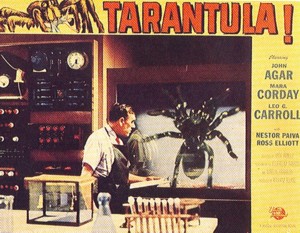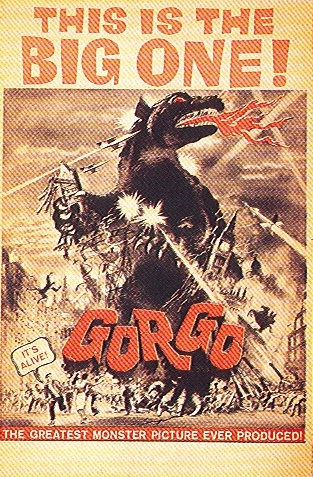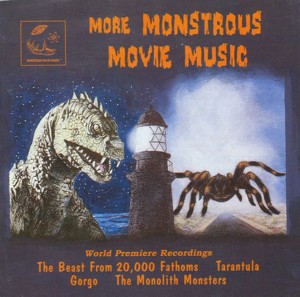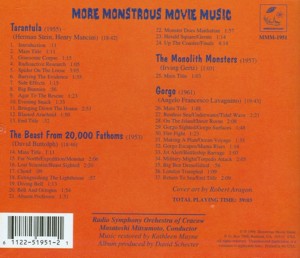| |
The Thunder ChildScience Fiction and Fantasy |
| |
|
| |
|
|
CD Review: More Monstrous Movie Music by Ryan Brennan
While many major Hollywood film releases had soundtrack Lps released, science fiction, horror and fantasy films were always slighted, creating a high level of frustration for the Monster Kid. In the pre-video days some people would set up their audio cassette or reel-to-reel tape recorders and tape the sound from these films in order to get the music. Later, home video made it possible to record just the music, albeit with sound effects and dialogue. Therein lies the primary benefit of this series from producer David Schecter and music restorationist Kathleen Mayne. Now these scores are available for our listening pleasure in state-of-the-art sound. Under the sensitive baton of conductor Masatoshi Mitsumoto it is a sublime listening experience.

Back to Control PanelTarantula (1955) was Universal-International's entry in the Giant Monster science fiction sub-genre, further sub-categorized as a Big Bug movie. It wasn't the first film in either category but it was the first to feature a giant spider. The popularity of giant spiders in movies continued with Earth Vs. The Spider, Have Rocket Will Travel, The Incredible Shrinking Man (the hero's tiny size making a giant of an ordinary arachnid), The Giant Spider Invasion, and the omnibus TV show Darkroom, to name a few, on forward into the present generation of filmmakers, most recently with Eight-Legged Freaks. Tarantula concerned the experiments of a scientist (Leo G. Carroll) meant to end world starvation through the creation of a synthetic food. Unfortunately, his formula induces acromegaly in humans while transforming animals and insects into giants. The title character manages to escape the lab and grow unhindered in the desert, feeding off whatever prey it can find. Eventually it tangles with our hero, John Agar, and moves toward the nearest high density population in town before being exterminated by pilot Clint Eastwood. The music, written by Herman Stein and Henry Mancini, starts with a piece that is repeated from the earlier U-I film Creature from the Black Lagoon. The "Main Title" is dramatic but genre neutral even though it comes from the Rock Hudson western The Lawless Breed. In fact, as David Schecter explains in his liner notes, only about 7:00 of music in the film is original, the rest of the 39:10 score is tracked in from other films (this album presents 18:42 of music). The primary sources cited by Schecter include It Came From Outer Space, This Island Earth, Six Bridges to Cross, Dawn at Socorro, Four Guns to the Border, and Smoke Signal, although there are many more. Web Site .hThat this cut-and-paste sort of music scoring could work, and did work over and over again, indicates that there's more to it than might meet the ear. A certain skill in selecting appropriate pieces and a familiarity with the music library was necessary. And the cues often had to be considerably altered before new recordings could be made. New musical bridges and segues were necessary to meld the pieces into a whole. It certainly is fun to listen to the score, the music clips bringing to mind the many motion pictures from which they came. Mancini's distinctive theme "The Thing Strikes," from It Came From Outer Space, retains its eerie resonance. A particular value of the Monstrous Movie Music collection is the frequent presentation of cues in their original state, before they were manipulated for tracking purposes. Herein, Herman Stein's cue "Bringing Down the House" is presented as it was written for the film Six Bridges to Cross. The Beast From 20,000 Fathoms (1953) was the first solo feature film for special effects genius Ray Harryhausen. It was also the prototype for the Giant Monster movies of the 1950s. Three films earlier in the decade featured dinosaurs but they were "Lost World" type stories and don't count. Beast was also the first Giant Monster film in which nuclear testing played a part, in this case awakening the creature from a millions-of-years slumber. Later films would warn against the misuse of nuclear testing by making radiation the culprit in the creation of the monster, turning normal size insects, animals, and even people into giants. The beast, a prehistoric Rhedosaurus (an invented name) is awakened in the icy Arctic and first sighted by Paul Christian, the only survivor of a mission to witness an A-bomb test. No one believes his story until a series of mysterious events are blamed on a sea monster matching the description of the dinosaur. It makes a bee-line for NYC, which happens to be the site of its ancestral breeding grounds. Coming ashore in the Big Apple, the Rhedosaurus wreaks havoc until it is finally cornered in a Coney Island amusement park and killed. taccess Editor Archive Gateway Disk Usage FTP FileManager FrontPage Extensions Google Custom Search Secure Server Server Information Set Site Editor View my Web site Visitor Statistics The movie was a sensation, racking up a box office of $5 million thanks to an innovative saturation advertising campaign on radio and TV and block theater bookings, a strategy taken from the same successful plan employed for the re-release of King Kong the previous year. Of course, Harryhausen's impressive special effects were what audiences paid to see and he certainly delivered the goods. WebSite Creator by CM4all E-Mail AutoResponder Change Catch-All MailCentral Manage Spam Filter POP Mail Beast was actually an independent film, produced outside a studio, and bought outright by Warner Brothers in what is called a negative pick-up deal. The film came with a score by Michel Michelet which was replaced by studio composer David Buttolph (House of Wax). Buttolph's score greatly enhances the film, adding a dramatic element that Michelet's effort reportedly lacked. Domain Add Registered Domain to Account Custom DNS Record Domain Central Domain Pointing Manager Registrar Transfer Subdomain Pointing Manager Account Information Billing Console Change Account Info Change E-Mail Addresses Change Password Manage Subscriptions Resend Account Info Set Security Question E-Commerce PowerPay - Accept Credit Cards ShopSite Scripting and Add-Ons CGI and Scripted Language Support Enhanced Script Library Form Builder InstaButtolph achieves a musical sense of great weight and mass by the use of powerful low brass, especially in the descending four-note theme for the monster. In most cases this theme is followed by two more heavy notes that suggest the lumbering movement of a great creature. Schecter remarks in his liner notes that the theme may have been overused in the film, and suggests this may have been at the behest of Warner Brothers personnel rather than Buttolph. Although the composer was forced to use it often -- he had only one week in which to write the 36 minute score -- there are spots where the music editor substituted the "Beast" theme for other Buttolph compositions. But in a fan's eye this is not necessarily a bad thing since the "Beast" theme is a particular favorite. Buttolph provides many shadings throughout the score and, like Bernard Herrmann's contemporaneous Beneath the 12-Mile Reef score, is quite good at painting musical pictures of water and underwater settings as heard in the cues "Diving Bell" and "Bell and Octopus." There is also a lovely lament that accents the loss of Cecil Kellaway's character in "Absent Professor." "Monster Does Manhattan," "Herald Square/Germs," and "Up The Coaster/Finale" all feature heavy use of the "Beast" theme and are exciting action cues. "Germs" offers a brief respite in the action as it is discovered that the Rhedosaurus' blood contains an airborne pathogen of virulent strength. For the information of the reader, these particular cue titles are mostly the work of Schecter as Buttolph's rushed schedule left little or no time for the task. The Monolith Monsters (1957) was an unusual science fiction entry in that the monsters are crystals. The film opens with visuals showing the Earth being bombarded by meteors burning up in our atmosphere. Narrator Paul Frees, a ubiquitous voice-over artist and bit player in the genre, informs us in his "voice of doom" that most meteors that make it through the atmosphere end up in the ocean. But, "from time to time, from the beginning of time" some meteors crash on dry land. After a series of meteor craters are shown Irving Gertzs "Main Title" begins, an urgent, unrelenting piece with militaristic echoes that musically exaggerates the thrills to come. Schecter notes that this piece, and much of the entire score to this film, is derived from the earlier The Deadly Mantis (1957). Another interesting aspect of the movie is that the title monster isnt sentient, its just a crystal weed that will continue to grow whenever watered, but that can no more have conscious designs on the Earth than a rock.

Just when it seemed like everything of monstrously huge proportions had hit the screen -- dinosaurs, ants, spiders, gila monsters, colossal men, deadly mantises, grasshoppers, giant claws, leeches, 50 foot and 30 foot women, wasps, blobs, etc -- along cameGorgo (1961), a late entry in the Giant Monster cycle. Gorgo had the benefit of direction by Eugene Lourie, who had helmed both The Beast From 20,000 Fathoms and the derivative (and redundantly titled) The Giant Behemoth (1959). It also was in color, a still relatively rare occurrence for genre pictures. And while the film provided the obligatory mass destruction of cityscapes by a man in a monster suit -- ala the highly successful suitmation technique employed by Godzilla and Godzilla Raids Again (U.S. title Gigantis the Fire Monster) -- the screenplay went one better and twisted audience expectations with a surprise ending. The score by Angelo Francesco Lavagnino is also a pleasant surprise. Lavagnino was an experienced hand with fantastic films having scored some of the Italian "peplum" pictures and the wonderfully ethereal score for the John Wayne, Sophia Loren film Legend of the Lost. The composer brings that otherworldly sound to his score for Gorgo, first with the main theme, then with other maritime moments, and finally at random moments throughout the score. Lavagnino doesn't skimp on the monster stuff, either, creating musical passages that communicate the power and might of the dinosaur (which must be said is a fantasy dinosaur by way of Godzilla). The "Main Title" begins with an appropriately "big" sound, one that could have opened a Biblical epic, and then turns to a lovely little melody, the main theme as played on the accordion. "On the Island" offers another accordion piece, cut from the film and heard hear for the first time, that seques into the main theme again. It is heard again in "Making a Plan" and in its most emotional incarnation during "Return to the Sea/End Title." Again, Schecter has renamed most of these cues because the original titles don't match any longer or are neutral.
|
|







